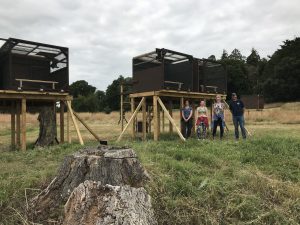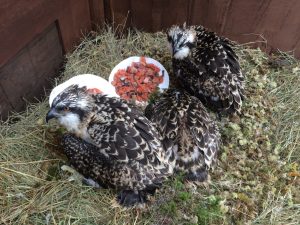The Poole Harbour Osprey Translocation Project started in 2017, initially as a 5 year project, but has since been extended. Birds of Poole Harbour is partnered with the Roy Dennis Wildlife Foundation to restore a breeding population of Ospreys to the South Coast, through translocating up to 60 Osprey chicks from Scotland and releasing them in the Poole Harbour area.
Permission for the project to go ahead was granted by Natural England after substantial evidence that Poole Harbour would be a suitable habitat for Ospreys to breed, as well as being an ideal location for a reintroduction project because of the high numbers of Ospreys passing through the harbour on migration. Prior to the project, attempts were made to encourage Ospreys to stay in the area over 8 years. This included the installation of several nesting platforms around the harbour, as well as the use of “decoy” Ospreys, intended to give the impression of Poole Harbour a breeding site to migrating Ospreys. Despite interest in the area and an increasing population passing through, there had still been no known nesting attempts on the South Coast, and so in 2017 the reintroduction project was given the go ahead.
Following similar procedures to the Rutland reintroduction project, each year up to 14 Osprey chicks of around 7 weeks of age are removed from nests in Scotland by experts from the Roy Dennis Wildlife Foundation. They are extensively checked to ensure they are in good health and ringed with a blue Darvic ring, along with the remaining chicks in the nests. There is always at least one chick left in an Osprey nest; on rare occasions two will be taken, and only from a nest of three or more. The larger chicks in the nest are collected, which gives smaller chicks greater survival prospects due to lowered competition for food. The chicks are then bought down to Dorset in July and spend the next few weeks in specially designed hacking pens.

These pens each have space for up to 3 chicks, reflecting a similar environment to a natural Osprey nest. The area is large enough for the birds to make developmental short flights and display “helicoptering” behaviour, demonstrating when they are strong enough to be fly and be released. Fish is prepared and supplied to the chicks three times daily, fed through a small hatch at the back of the pens to minimise human contact. They are monitored throughout the day by a dedicated team of staff and volunteers using a high-quality camera for each pen. When all the birds have displayed important development behaviours, the Ospreys are ready to be released, and so they are fitted with a radio tag so that they can be tracked.

Following their release, the birds are still supplied with fish, but instead on feeding nests outside of the pens, which replicate the appearance of a natural nest. The progress of the juveniles is monitored through feeding cameras and regular scans using a yagi – specialist equipment used to locate the birds from their radio tags. The Ospreys stay close to the release site and within the Poole Harbour area for at least a month, strengthening their flight and increasing their body mass for their eventual migration. The juveniles will usually leave the Harbour between the end of August and the end of September, travelling to their wintering grounds which are typically in West Africa. The released Ospreys will then spend the next few years at this destination, maturing until they are ready to breed themselves. During the month spent exploring the area before they migrate, they imprint on the surrounding, and so when the birds are ready to return, they will recognise Dorset as home. This is highly important as male Ospreys set up territory and therefore look for nesting opportunities close to where they fledged, and so the success of the project relies upon them forming this connection with the local area.
To read about years 1-4 of the project, have a look at our blog pages.
Since 2017, which marked the start of the Poole Harbour Osprey Translocation Project, there has been a resident female, ringed CJ7, who has returned to the area each summer. CJ7 fledged from a nesting site in Rutland in 2015, but was seemingly attracted to Poole Harbour by the young birds released through the project. In 2019, when a young translocated male, LS7, returned for the first time, CJ7 bonded with him over the summer, creating potential for nesting the following year. However, LS7 did not return again in 2020, and so the hope for a returning male to breed with CJ7 continued.
Fortunately, in 2021, a new translocated male returned on the 18th May, ringed 022, one of the 2019 cohort. They were quick to pair up and start establishing a bond, ready for potential breeding in 2022. Their return in Spring 2022 led to the first breeding attempt on the South Coast in nearly 200 years at Careys Secret Garden, laying 3 eggs during April, two of which subsequently hatched and were ringed 5H1 and 5H2. Sadly, 5H2 was predated by a Goshawk soon after fledging, but we were delighted that 5H1 safely left on migration.
CJ7 and 022 have now bred for 3 consecutive years, rearing 3 young in 2023 (5H3, 5H4 and 5H5) and a further 4 in 2024. Excitingly, female 5H1 returned to the UK for the first time in 2024, becoming the first wild-fledged chick from the project to return. You can watch our livestream webcams of the nest here.
In 2023, another male from the project returned to Poole Harbour, ringed 374 from the 2021 cohort. He spent the summer in the area and returned again in 2024, seen both Dorset and Hampshire, but appears not to have yet settled in an area.
There have also been positive outcomes from the project elsewhere in the UK. Back in 2020, another translocated Osprey from the project, this time a female ringed 014 from 2018, returned to the UK. 014 didn’t return to Poole Harbour, instead being first discovered on the Dyfi Osprey Project nest camera. She spent the remainder of the summer exploring different locations in Wales, frequently with a male Osprey in tow, and settled on a nest near the Glaslyn Osprey Visitor Centre in 2021 with a male Osprey, ringed Blue Z2, and have successfully reared young every year since. Not far from her, another female ringed 019, who was released as part of the project in 2019, has also been nesting since 2021. In 2024, a third female ringed 372, who was released in 2021, bred for the first time at Lyn Brenig, and can be watched via livestream webcam!
© 2025 Birds of Poole Harbour Registered Charity No. 1152615